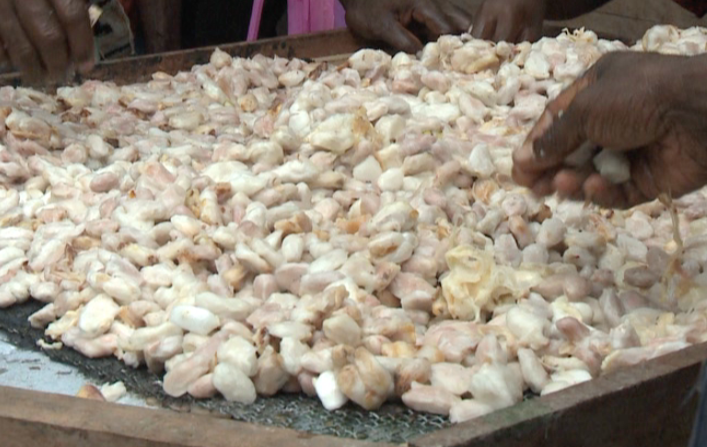Harvesting and processing of cocoa beans is long-standing agricultural practice by cocoa farmers all around the world.
After the ripe cocoa pods (Theobroma cacao L) are harvested, they have to be fermented and dried in order to help produce a pleasant bitterness and other desired flavors needed by chocolate makers.
The cocoa beans are then fractured and placed into fermentation boxes (pictured) and covered with banana leaves then a layer of clean hessian bags (not bags that have contained copra, which will taint the cocoa) – this is needed to keep the
heat in the fermentation mass.

least 50 cm deep with cocoa beans; it holds about 200kg beans (from about
1600 pods). P A P U A N E W G U I N E A C O C O A F A R M E R ’ S H A N D B O O K
When the Fermentation mass turns brown, with a vinegar smell, the mass is heating up to indicate a good process.
The Fermentation process should last for 6 days and not more than that. After fermentation, the drying process begins.
Cocoa beans can be dried on simple platforms in the sun if the environmental conditions are not too wet; platforms are covered with tarpaulins or clear plastic sheets in the event of rain; globally, most cocoa is sun-dried.
However, in many places in Papua New Guinea, it is too wet during the main harvest season for simple passive sun-drying to be rapid enough to give good quality cocoa beans.
A wood-fired kiln drier on the design shown below has been developed in Papua New Guinea to speed up the sun drying of cocoa beans.
• A steel kiln pipe is built under a metal mesh drying rack on
which the beans are spread about 5cm deep.
• A roof can be rolled off to expose the beans for sun drying when
the weather is dry.
• During wet weather the roof is rolled over the drying rack and
wood in the kiln is lit to provide heat to continue drying the
beans.

The Kiln pipes, however, tend to rust and develop holes over time, and this allows smoke to pass through, tainting the beans. Also, the fragments tend to fall down from the drying rack and burn on the kiln pipe, creating smoke.
The PNG Cocoa Board is now trialing the use of stainless steel to dry cocoa beans.
Last week, the PNG Cocoa Board was in Navunaram village in the Gazelle district of East New Britain to launch the trialing of this new method.
While PNG produces some of the best cocoa in the world, it still needs improvement and PNG Cocoa Board continues to remain committed to improving the quality of cocoa in PNG.


